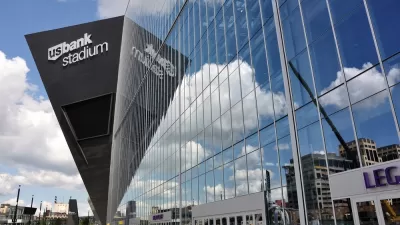Reflective glass high-rises kill millions of birds each year, but bird-friendly design can save birds and reduce energy consumption.

Architects know how to stop birds from flying into buildings, writes Alexandra Lange—but "those standards clash with the big glass and big views that clients associate with big money." To prevent birds from mistaking reflective glass windows for trees or open space, designers can use patterned glass, exterior screens, and reduced lighting. But according to Kate Orff of architecture and design studio SCAPE, an emphasis on giant glass panes has turned Manhattan into "a giant bird killer."
During last September's fall migration season, volunteers with NYC Audubon's collision monitoring project documented hundreds of bird strikes at the World Trade Center, and a heightened interest in birdwatching during the pandemic has led more people to pay attention to, and want to save, urban birds.
In early 2021, New York City implemented legislation that mandates bird-friendly design in new buildings and requires city buildings to turn off nonessential lighting at night during migration season.
The best example of a bird-safe retrofit, from the point of view of scale and effectiveness, is Manhattan’s Javits Center, which spent five years replacing the convention center’s clear glass with panels covered in tiny ceramic dots as part of a $500 million environmental retrofit that also added a 6.75-acre green roof. Almost imperceptible to the human eye, those dots nonetheless cut bird death by 90% — and energy consumption by 26%.
The article points out that bird collisions don't just happen with high-rise buildings, but there are low-cost changes homeowners can make to reduce bird strikes at home, such as safety netting or patterned window films.
FULL STORY: Buildings Don't Have To Be Bird-Killers

Planetizen Federal Action Tracker
A weekly monitor of how Trump’s orders and actions are impacting planners and planning in America.

DARTSpace Platform Streamlines Dallas TOD Application Process
The Dallas transit agency hopes a shorter permitting timeline will boost transit-oriented development around rail stations.

Four Reasons Urban Planners Can’t Ignore AI
It’s no longer a question of whether AI will shape planning, but how. That how is up to us.

Texas State Bills to Defund Dallas Transit Die
DART would have seen a 30% service cut, $230M annual losses had the bills survived.

Bikeshare for the Win: Team Pedals to London Cricket Match, Beats Rivals Stuck in Traffic
While their opponents sat in gridlock, England's national cricket team hopped Lime bikes, riding to a 3-0 victory.

Amtrak’s Borealis Exceeds First Year Ridership Expectations
205,800 passengers have boarded the St. Paul to Chicago line, well above initial MDOT projections.
Urban Design for Planners 1: Software Tools
This six-course series explores essential urban design concepts using open source software and equips planners with the tools they need to participate fully in the urban design process.
Planning for Universal Design
Learn the tools for implementing Universal Design in planning regulations.
City of Mt Shasta
City of Camden Redevelopment Agency
City of Astoria
Transportation Research & Education Center (TREC) at Portland State University
US High Speed Rail Association
City of Camden Redevelopment Agency
Municipality of Princeton (NJ)





























